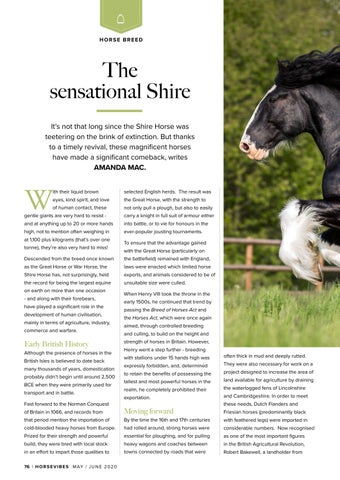HORSE BREED
The sensational Shire It’s not that long since the Shire Horse was teetering on the brink of extinction. But thanks to a timely revival, these magnificent horses have made a significant comeback, writes AMANDA MAC.
W
ith their liquid brown
selected English herds. The result was
eyes, kind spirit, and love
the Great Horse, with the strength to
of human contact, these
not only pull a plough, but also to easily
gentle giants are very hard to resist -
carry a knight in full suit of armour either
and at anything up to 20 or more hands
into battle, or to vie for honours in the
high, not to mention often weighing in
ever-popular jousting tournaments.
at 1,100 plus kilograms (that’s over one tonne), they’re also very hard to miss!
To ensure that the advantage gained with the Great Horse (particularly on
Descended from the breed once known
the battlefield) remained with England,
as the Great Horse or War Horse, the
laws were enacted which limited horse
Shire Horse has, not surprisingly, held
exports, and animals considered to be of
the record for being the largest equine
unsuitable size were culled.
on earth on more than one occasion - and along with their forebears, have played a significant role in the development of human civilisation, mainly in terms of agriculture, industry, commerce and warfare.
Early British History Although the presence of horses in the British Isles is believed to date back many thousands of years, domestication probably didn’t begin until around 2,500 BCE when they were primarily used for transport and in battle.
When Henry VIII took the throne in the early 1500s, he continued that trend by passing the Breed of Horses Act and the Horses Act, which were once again aimed, through controlled breeding and culling, to build on the height and strength of horses in Britain. However, Henry went a step further - breeding with stallions under 15 hands high was expressly forbidden, and, determined to retain the benefits of possessing the tallest and most powerful horses in the realm, he completely prohibited their
often thick in mud and deeply rutted. They were also necessary for work on a project designed to increase the area of land available for agriculture by draining the waterlogged fens of Lincolnshire
exportation.
and Cambridgeshire. In order to meet
of Britain in 1066, and records from
Moving forward
Friesian horses (predominantly black
that period mention the importation of
By the time the 16th and 17th centuries
with feathered legs) were imported in
cold-blooded heavy horses from Europe.
had rolled around, strong horses were
considerable numbers. Now recognised
Prized for their strength and powerful
essential for ploughing, and for pulling
as one of the most important figures
build, they were bred with local stock
heavy wagons and coaches between
in the British Agricultural Revolution,
in an effort to impart those qualities to
towns connected by roads that were
Robert Bakewell, a landholder from
Fast forward to the Norman Conquest
76 | H O R S E V I B E S M AY / J U N E 2 0 2 0
these needs, Dutch Flanders and





















